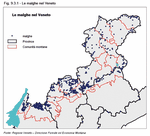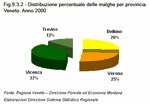As already stated in the introduction, the exodus from mountain areas has caused problems for the maintenance of the territory, but has also led to the abandoning of traditional dairy farming in the Veneto mountains. From 1970 to 2000, general census data on farming reveals a 35% reduction in pastureland in mountain areas. This mainly became part of expanding woodland. If only certain areas are analysed, such as mountains in the province of Belluno (which includes five Mountain Communities), over 60% of pastureland has been lost. This highlights a critical situation which poses serious economic and environmental problems and raises important questions concerning the return of these areas to productive land.
The dairy farms are situated in wood and pastureland, are larger than 10 hectares, have adequate infrastructure consisting of pastures and, in some cases, woodland, accommodation for the workers, shelter for the animals, and rooms for the production and conservation of the finished dairy products. According to a study conducted by the Servizi Forestali Regionali in 2000, there were more than 500 State and private mountain dairy farms in Veneto. Most are situated in the Mountain Community of the Spettabile Reggenza dei Sette Comuni and Lessinia, where more than one-third of the region's mountain dairy farms are concentrated
(Figure 9.3.1).
In 37% of cases, mountain dairy farms are in the province of Vicenza, 26% in the province of Belluno, 25% in the province of Verona, while 12% are in the province of Treviso
(Figure 9.3.2).
State mountain dairy farms, unlike the private ones, are subject to a particular technical and economic code of use which, up until 2001, was approved by the region, but which is currently approved by the Mountain Communities concerned. The aim of the code is the hydrogeological protection of the pastureland, which could be put at risk by an excessive number of livestock but also by incorrect grazing methods. Apart from damage to grassland from overgrazing and consequent hydrogeological problems, undergrazing can also be damaging because of the resulting spread of woody plants and grasses that are not eaten by livestock.
As well as the problem of optimum pasture management, mountain dairy farms are currently subject to precise health and hygiene regulations
(Note 1) for the on-site production of dairy products. Respecting the regulations means carrying out significant interventions, mainly aimed at the adaptation of rooms for milking, dairy production and product storage. Equipment is also affected.
Farms that adhere to these regulations achieve EU quality standards in this unique, fundamental mountain area activity. If these standards, essential to maintaining production of dairy products on mountain farms, are not respected, the farms will be forced to close. This would result in considerable loss in terms of the protection of typical local products, as well as the heavy side effects on the income of the producers. The abovementioned measures to adapt farms so that they respect regulations lead to the formation of more efficient farms which are able to ensure improvement in terms of quality and quantity. This constitutes essential requirements for the agrotourism industry and more generally to keeping people in mountain areas.
The valorisation of these mountain dairy farms has been essential to the development strategies of mountain areas since the 1970s. In recent years these strategies have seen the concept of multifunctionality prevailing in mountain farming. The promotion of pastureland activity, whilst initially concentrated on an increase in productivity, is now directed at the valorisation of the mountain dairy farm essentially for its intrinsic value. This is mainly tied in with the conservation of the environment and landscape of the mountains, with its cultural and historical values, with the genuineness and uniqueness of the farm produce made there and with the potential for tourism connected to these values.






